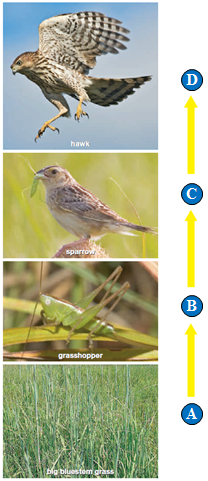
Figure 46.2
?
The following question refers to the accompanying figure illustrating a tallgrass prairie food chain.
?
The letter D indicates the ____.
A. first trophic level
B. second trophic level
C. third trophic level
D. fourth trophic level
E. fifth trophic level
Answer: D
You might also like to view...
Which of the following statements about sister chromatids is TRUE? rev:
A. Sister chromatids are produced during mitosis. B. Sister chromatids are held together by complementary base pairing of DNA at the centromere. C. Sister chromatids are exact copies of each other and are formed just prior to cell division. D. After mitosis, sister chromatids contain the same genes, but they may have different alleles. E. All of these statements about sister chromatids are TRUE.
An isotonic solution has a solute concentration ____ to the solute concentration inside the cell
a. equal b. greater than c. less than d. it would depend on the solute e. it would depend on the type of cell
Some people trying to lose weight have gone on the Atkins diet, in which they eat mostly high-protein, low-carbohydrate foods such as meat, cheese, and eggs
The amino acids in these protein-rich diets, such as alanine, glycine, and serine, can be converted to pyruvate by deamination (removal of the amino group). Based on this scenario as well as your knowledge of cellular respiration, how many ATP, NADH, and FADH2 molecules will be generated from one molecule of alanine during the mitochondrial matrix reactions? Hint: Only consider the reactions from the point at which the alanine carbons enter cellular respiration. A) 2 FADH2, 6 NADH, and 2 ATP B) 1 FADH2, 1 NADH, and 1 ATP C) 2 FADH2, 3 NADH, and 2 ATP D) 0 FADH2, 1 NADH, and 2 ATP E) 1 FADH2, 4 NADH, and 1 ATP
All of the following pertain to serological tests EXCEPT
A) they can detect antibodies but not antigens. B) they can be used to diagnose various diseases. C) reactions can be detected by uptake of trypan blue by damaged cells. D) they are used to test for specific HLAs on lymphocytes. E) they are used to detect compatible tissues for transplantation.